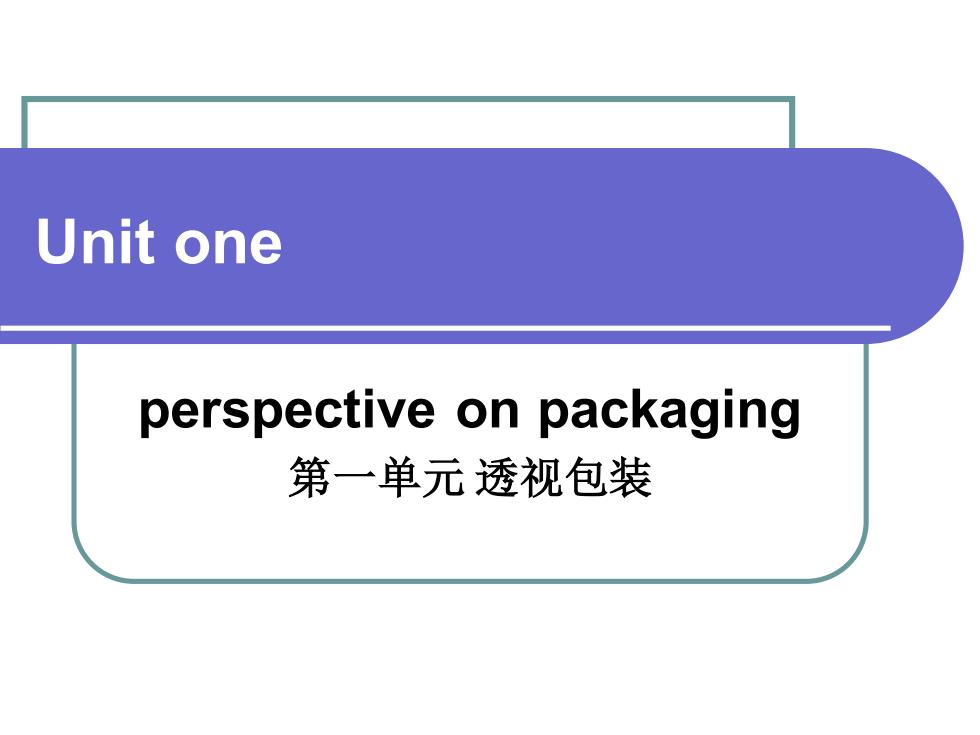
Unit one perspective on packaging 第一单元 透视包装
Unit one perspective on packaging 第一单元 透视包装
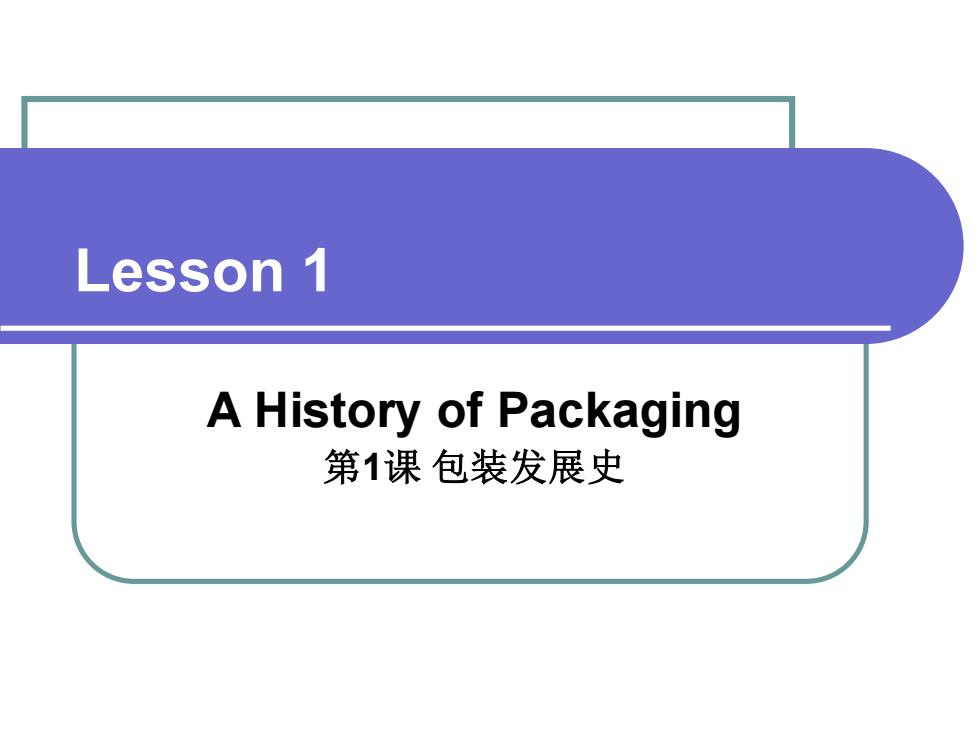
Lesson 1 A History of Packaging 第1课 包装发展史
Lesson 1 A History of Packaging 第1课 包装发展史
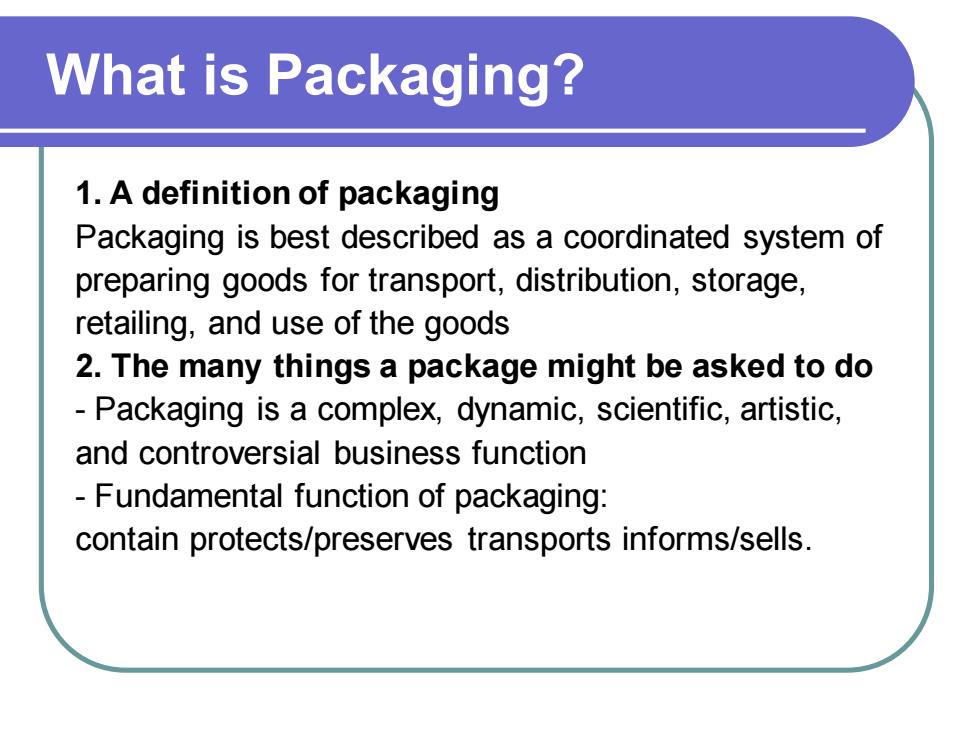
What is Packaging? 1. A definition of packaging Packaging is best described as a coordinated system of preparing goods for transport, distribution, storage, retailing, and use of the goods 2. The many things a package might be asked to do - Packaging is a complex, dynamic, scientific, artistic, and controversial business function - Fundamental function of packaging: contain protects/preserves transports informs/sells
What is Packaging? 1. A definition of packaging Packaging is best described as a coordinated system of preparing goods for transport, distribution, storage, retailing, and use of the goods 2. The many things a package might be asked to do - Packaging is a complex, dynamic, scientific, artistic, and controversial business function - Fundamental function of packaging: contain protects/preserves transports informs/sells
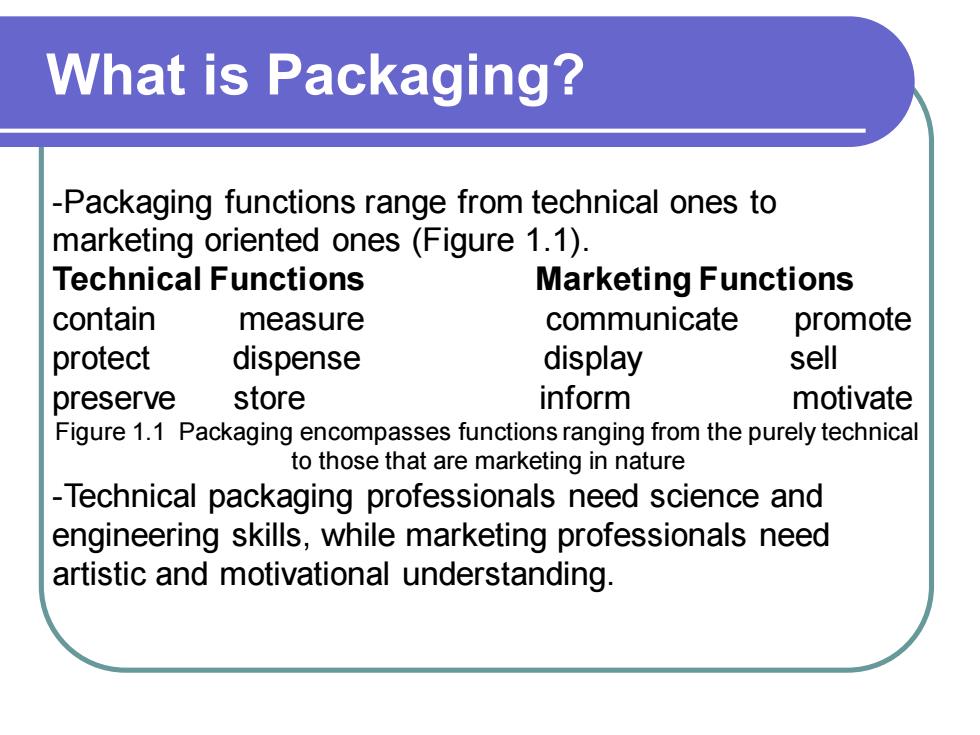
What is Packaging? -Packaging functions range from technical ones to marketing oriented ones (Figure 1.1). Technical Functions Marketing Functions contain measure communicate promote protect dispense display sell preserve store inform motivate Figure 1.1 Packaging encompasses functions ranging from the purely technical to those that are marketing in nature -Technical packaging professionals need science and engineering skills, while marketing professionals need artistic and motivational understanding
What is Packaging? -Packaging functions range from technical ones to marketing oriented ones (Figure 1.1). Technical Functions Marketing Functions contain measure communicate promote protect dispense display sell preserve store inform motivate Figure 1.1 Packaging encompasses functions ranging from the purely technical to those that are marketing in nature -Technical packaging professionals need science and engineering skills, while marketing professionals need artistic and motivational understanding

What is Packaging? 3. How packaging changes to meet society’s needs - Packaging is not a recent phenomenon. - Packaging is an activity closely associated with the evolution of society and, can be traced back to human beginnings. - The nature, degree, and amount of packaging at any stage of a society’s growth reflect the needs, cultural patterns, material availability and technology of that society. - A study of packaging’s changing roles and forms over the centuries is a study of the growth of civilization. - Social changes are inevitably reflected in the way we package, deliver and consume goods
What is Packaging? 3. How packaging changes to meet society’s needs - Packaging is not a recent phenomenon. - Packaging is an activity closely associated with the evolution of society and, can be traced back to human beginnings. - The nature, degree, and amount of packaging at any stage of a society’s growth reflect the needs, cultural patterns, material availability and technology of that society. - A study of packaging’s changing roles and forms over the centuries is a study of the growth of civilization. - Social changes are inevitably reflected in the way we package, deliver and consume goods
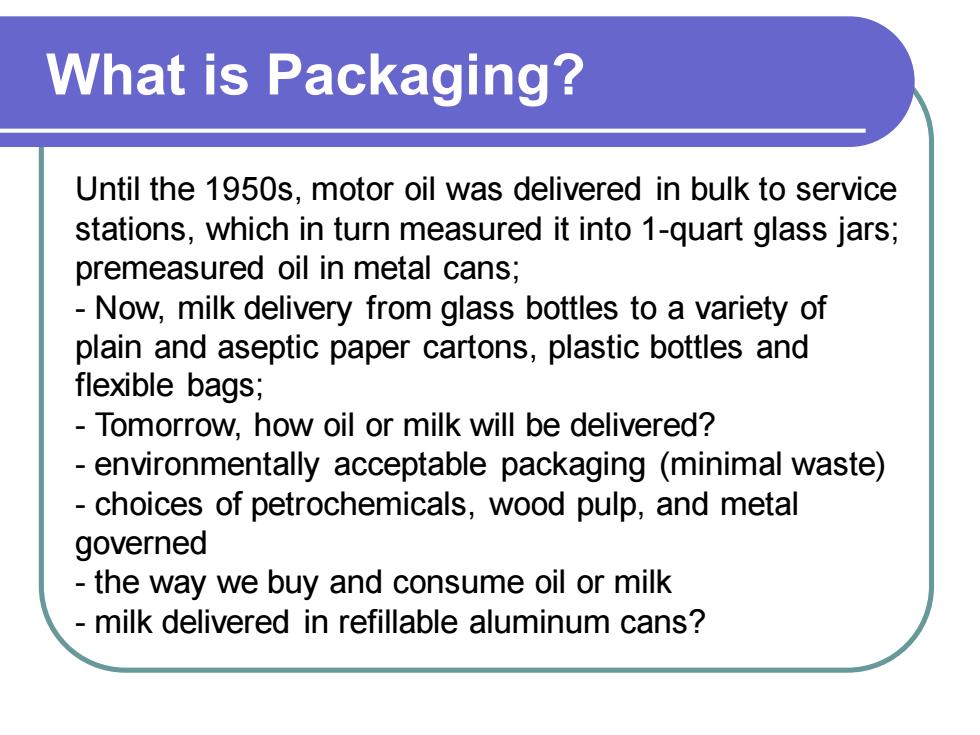
What is Packaging? Until the 1950s, motor oil was delivered in bulk to service stations, which in turn measured it into 1-quart glass jars; premeasured oil in metal cans; - Now, milk delivery from glass bottles to a variety of plain and aseptic paper cartons, plastic bottles and flexible bags; - Tomorrow, how oil or milk will be delivered? - environmentally acceptable packaging (minimal waste) - choices of petrochemicals, wood pulp, and metal governed - the way we buy and consume oil or milk - milk delivered in refillable aluminum cans?
What is Packaging? Until the 1950s, motor oil was delivered in bulk to service stations, which in turn measured it into 1-quart glass jars; premeasured oil in metal cans; - Now, milk delivery from glass bottles to a variety of plain and aseptic paper cartons, plastic bottles and flexible bags; - Tomorrow, how oil or milk will be delivered? - environmentally acceptable packaging (minimal waste) - choices of petrochemicals, wood pulp, and metal governed - the way we buy and consume oil or milk - milk delivered in refillable aluminum cans?
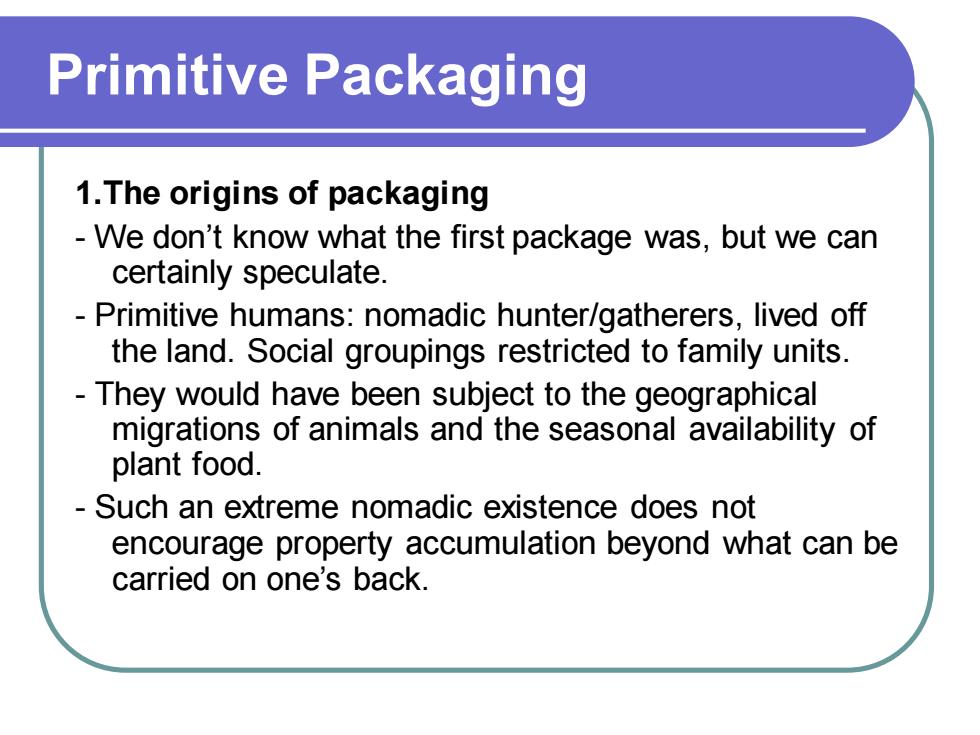
Primitive Packaging 1.The origins of packaging - We don’t know what the first package was, but we can certainly speculate. - Primitive humans: nomadic hunter/gatherers, lived off the land. Social groupings restricted to family units. - They would have been subject to the geographical migrations of animals and the seasonal availability of plant food. - Such an extreme nomadic existence does not encourage property accumulation beyond what can be carried on one’s back
Primitive Packaging 1.The origins of packaging - We don’t know what the first package was, but we can certainly speculate. - Primitive humans: nomadic hunter/gatherers, lived off the land. Social groupings restricted to family units. - They would have been subject to the geographical migrations of animals and the seasonal availability of plant food. - Such an extreme nomadic existence does not encourage property accumulation beyond what can be carried on one’s back
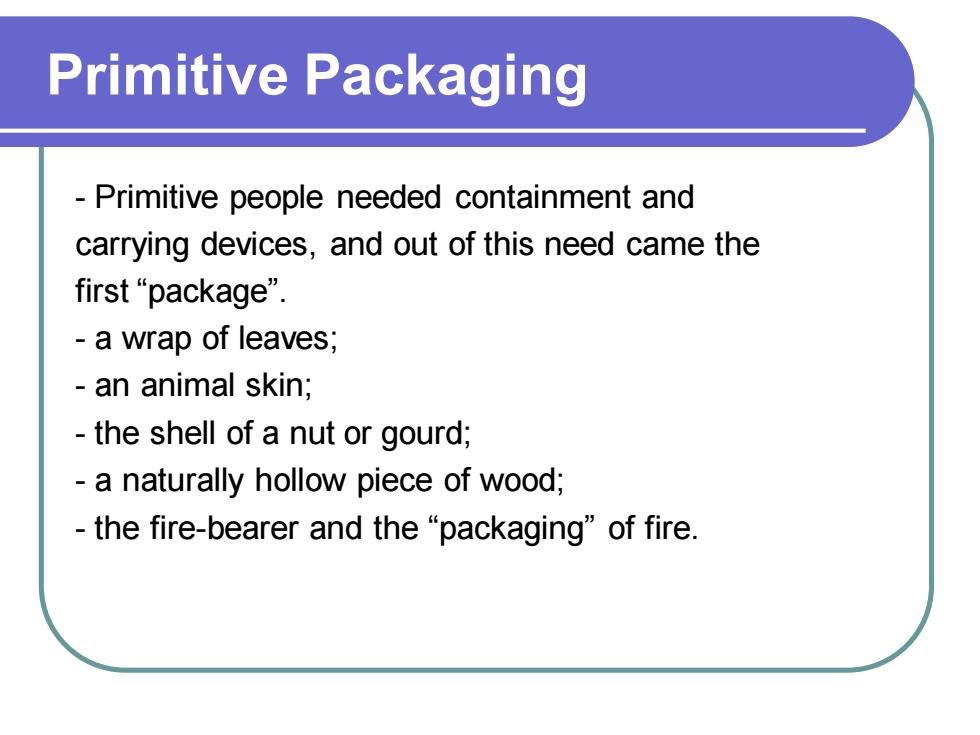
Primitive Packaging - Primitive people needed containment and carrying devices, and out of this need came the first “package”. - a wrap of leaves; - an animal skin; - the shell of a nut or gourd; - a naturally hollow piece of wood; - the fire-bearer and the “packaging” of fire
Primitive Packaging - Primitive people needed containment and carrying devices, and out of this need came the first “package”. - a wrap of leaves; - an animal skin; - the shell of a nut or gourd; - a naturally hollow piece of wood; - the fire-bearer and the “packaging” of fire

Primitive Packaging 2.How packaging changed as social structures changed - 5000 B.C., domesticated plants and animals. - a reasonable food supply in a given vicinity; - evolutionary stage: supported larger social groups, gave birth to small tribal villages; - storage and transport containers needed for milk, honey, seed grains, nuts, and dried meat; - villages with access to different resources traded with their neighbors, requiring transport containers; - About 250 B.C., the Greek city-state period, law that affected packaging enacted
Primitive Packaging 2.How packaging changed as social structures changed - 5000 B.C., domesticated plants and animals. - a reasonable food supply in a given vicinity; - evolutionary stage: supported larger social groups, gave birth to small tribal villages; - storage and transport containers needed for milk, honey, seed grains, nuts, and dried meat; - villages with access to different resources traded with their neighbors, requiring transport containers; - About 250 B.C., the Greek city-state period, law that affected packaging enacted

Primitive Packaging 3. Early packaging materials - fabricated sacks, baskets, and bags, made from materials of plant or animal origin; wood boxes replaced hollow logs; a clay bowl, the fire-dried clay pots ( the pottery and ceramic trade). 4. The discovery of glass - By 2500 B.C., a hard inert substance in the fire’s remains; glass beads and figures made in Mesopotamia (today’s Iraq). - About 1500 B.C., the earliest hollow glass objects appeared in Mesopotamia and Egypt
Primitive Packaging 3. Early packaging materials - fabricated sacks, baskets, and bags, made from materials of plant or animal origin; wood boxes replaced hollow logs; a clay bowl, the fire-dried clay pots ( the pottery and ceramic trade). 4. The discovery of glass - By 2500 B.C., a hard inert substance in the fire’s remains; glass beads and figures made in Mesopotamia (today’s Iraq). - About 1500 B.C., the earliest hollow glass objects appeared in Mesopotamia and Egypt